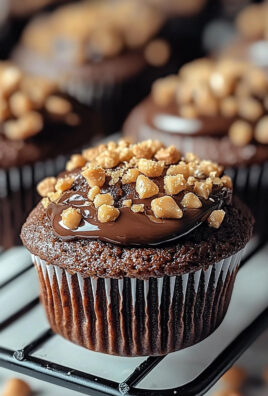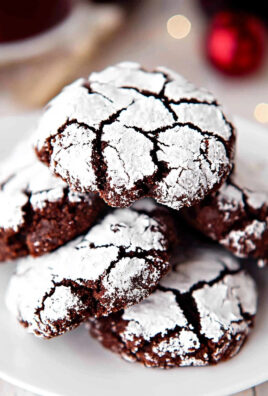Matera Cakes, a taste of Southern Italy in every bite! Have you ever dreamt of a dessert that perfectly balances rustic charm with elegant simplicity? These delightful cakes, hailing from the ancient city of Matera in Basilicata, Italy, are exactly that. Imagine sinking your teeth into a moist, almond-infused crumb, subtly flavored with lemon and a hint of local honey. It’s an experience that transports you straight to the sun-drenched hills of Southern Italy.
Matera, a UNESCO World Heritage site, is renowned for its “Sassi,” cave dwellings inhabited since the Paleolithic era. These cakes, like the city itself, carry a rich history. Passed down through generations, the recipe for Matera Cakes reflects the resourcefulness and culinary traditions of the region. They were often baked for special occasions, using simple, locally sourced ingredients.
What makes these cakes so irresistible? It’s the unique combination of textures a slightly crisp exterior giving way to a tender, almost melt-in-your-mouth interior. The almond flour provides a delicate nutty flavor, while the lemon zest adds a refreshing zing. Plus, they are incredibly easy to make! Whether you’re a seasoned baker or a kitchen novice, you’ll find this recipe straightforward and rewarding. Get ready to impress your friends and family with a taste of authentic Italian heritage!
Ingredients:
- For the Sponge Cake:
- 250g all-purpose flour, plus extra for dusting
- 1 teaspoon baking powder
- 1/2 teaspoon baking soda
- 1/4 teaspoon salt
- 200g granulated sugar
- 120ml vegetable oil
- 2 large eggs
- 240ml buttermilk
- 1 teaspoon vanilla extract
- 1 teaspoon lemon zest, finely grated
- For the Pastry Cream:
- 500ml whole milk
- 1 vanilla bean, split lengthwise and seeds scraped (or 1 teaspoon vanilla extract)
- 100g granulated sugar
- 4 large egg yolks
- 40g cornstarch
- 25g unsalted butter, cut into small pieces
- For the Alchermes Syrup:
- 100ml water
- 100g granulated sugar
- 50ml Alchermes liqueur
- For the Decoration:
- Powdered sugar, for dusting
- Candied cherries, halved (optional)
Preparing the Sponge Cake:
- Preheat and Prepare: First things first, preheat your oven to 175°C (350°F). Grease and flour a 9-inch round cake pan. Make sure you get into all the nooks and crannies to prevent sticking. I like to use a baking spray that contains flour for extra insurance.
- Combine Dry Ingredients: In a medium bowl, whisk together the flour, baking powder, baking soda, and salt. This ensures that the leavening agents are evenly distributed throughout the batter. Nobody wants a cake with pockets of baking powder!
- Combine Wet Ingredients: In a separate, larger bowl, whisk together the sugar and vegetable oil until well combined. The mixture should look slightly pale and creamy.
- Add Eggs: Beat in the eggs one at a time, making sure each egg is fully incorporated before adding the next. This helps to create a smooth and emulsified batter.
- Alternate Wet and Dry: Gradually add the dry ingredients to the wet ingredients, alternating with the buttermilk. Begin and end with the dry ingredients. I usually do it in three additions of dry and two of wet. This prevents the gluten from developing too much, resulting in a tender cake. Mix until just combined; be careful not to overmix. Overmixing leads to a tough cake.
- Add Flavor: Stir in the vanilla extract and lemon zest. The lemon zest adds a lovely brightness that complements the other flavors.
- Pour and Bake: Pour the batter into the prepared cake pan and spread it evenly. Bake for 30-35 minutes, or until a wooden skewer inserted into the center comes out clean.
- Cool: Let the cake cool in the pan for 10 minutes before inverting it onto a wire rack to cool completely. This prevents the cake from sticking to the pan and allows it to cool evenly.
Preparing the Pastry Cream:
- Infuse the Milk: In a medium saucepan, combine the milk and vanilla bean (or vanilla extract). Heat over medium heat until just simmering. If using a vanilla bean, remove it from the heat and let it steep for 30 minutes to infuse the milk with flavor. Remove the vanilla bean before proceeding, scraping out the seeds and adding them back to the milk.
- Whisk Egg Yolks and Sugar: In a separate bowl, whisk together the egg yolks and sugar until pale and thick. This is an important step to ensure a smooth and creamy pastry cream.
- Add Cornstarch: Whisk in the cornstarch until fully incorporated. Make sure there are no lumps of cornstarch remaining.
- Temper the Egg Yolks: Slowly pour about 1/2 cup of the hot milk into the egg yolk mixture, whisking constantly to prevent the eggs from scrambling. This process is called tempering and gradually raises the temperature of the egg yolks.
- Combine and Cook: Pour the tempered egg yolk mixture back into the saucepan with the remaining milk. Cook over medium heat, whisking constantly, until the mixture thickens and comes to a boil. Continue to cook for 1-2 minutes, whisking vigorously, to ensure the cornstarch is fully cooked.
- Add Butter: Remove the saucepan from the heat and stir in the butter until melted and smooth. The butter adds richness and shine to the pastry cream.
- Cool: Pour the pastry cream into a clean bowl, cover the surface with plastic wrap (pressing it directly onto the cream to prevent a skin from forming), and refrigerate for at least 2 hours, or preferably overnight, to allow it to cool completely and thicken.
Preparing the Alchermes Syrup:
- Combine Ingredients: In a small saucepan, combine the water and sugar.
- Simmer: Heat over medium heat, stirring until the sugar is dissolved.
- Cool and Add Liqueur: Remove from heat and let cool completely. Stir in the Alchermes liqueur. The syrup will turn a vibrant red color.
Assembling the Matera Cakes:
- Cut the Cake: Once the sponge cake is completely cool, use a serrated knife to cut it horizontally into two equal layers.
- Soak the Cake: Place the bottom layer of the cake on a serving plate. Generously brush it with the Alchermes syrup. Don’t be shy; you want the cake to be moist and flavorful.
- Add Pastry Cream: Spread the chilled pastry cream evenly over the soaked bottom layer of the cake.
- Top with Second Layer: Carefully place the top layer of the cake over the pastry cream.
- Soak the Top Layer: Brush the top layer of the cake with the remaining Alchermes syrup.
- Chill: Refrigerate the assembled cake for at least 30 minutes to allow the flavors to meld together.
- Decorate: Just before serving, dust the top of the cake generously with powdered sugar.
- Garnish (Optional): If desired, garnish with halved candied cherries.
- Serve: Slice and serve chilled. Enjoy!
Tips for Success:
- Use Room Temperature Ingredients: For the sponge cake, using room temperature eggs and buttermilk will help the batter come together more easily and result in a lighter, fluffier cake.
- Don’t Overmix: Overmixing the sponge cake batter will develop the gluten in the flour, resulting in a tough cake. Mix until just combined.
- Prevent Skin on Pastry Cream: Press plastic wrap directly onto the surface of the pastry cream while it cools to prevent a skin from forming.
- Adjust Sweetness: Adjust the amount of sugar in the pastry cream and Alchermes syrup to your liking.
- Alchermes Substitute: If you can’t find Alchermes liqueur, you can substitute with a mixture of red food coloring and a small amount of brandy or rum. However, the flavor will not be exactly the same.
Variations:
- Chocolate Pastry Cream: Add 2 tablespoons of cocoa powder to the pastry cream along with the cornstarch for a chocolate version.
- Citrus Pastry Cream: Add the zest of an orange or lemon to the pastry cream for a citrusy twist.
- Different Liqueur: Experiment with different liqueurs in the syrup, such as Grand Marnier or Amaretto.

Conclusion:
This isn’t just another cake recipe; it’s an invitation to experience a taste of Southern Italy, right in your own kitchen. The Matera Cakes, with their delicate crumb, subtle sweetness, and hint of lemon, are truly something special. I’ve shared this recipe with countless friends and family, and it’s always a resounding success. The simplicity of the ingredients belies the incredible flavor and texture you’ll achieve. Trust me, once you try these, you’ll be adding them to your regular baking rotation.
But why is this recipe a must-try? It’s more than just the delicious taste. It’s the ease of preparation. You don’t need to be a seasoned baker to create these little masterpieces. The instructions are straightforward, and the ingredients are readily available. Plus, the aroma that fills your kitchen as they bake is simply divine a comforting and inviting scent that will have everyone eagerly anticipating the first bite. It’s a perfect recipe for a weekend baking project, a special occasion treat, or simply a way to brighten up a weekday afternoon.
And the versatility! Oh, the possibilities are endless! While the classic recipe is wonderful on its own, feel free to experiment with variations. A dusting of powdered sugar adds a touch of elegance. A drizzle of lemon glaze takes the citrus notes to the next level. For a richer flavor, try adding a handful of chopped almonds or pistachios to the batter. You could even incorporate a few drops of almond extract for a more pronounced nutty flavor.
Serving suggestions? These Matera Cakes are delightful served warm with a scoop of vanilla ice cream or a dollop of whipped cream. They also pair beautifully with a cup of strong coffee or a glass of sweet dessert wine. For a more casual presentation, arrange them on a platter and let everyone help themselves. They’re perfect for afternoon tea, brunch, or a light dessert after dinner. You can even pack them in a picnic basket for a delightful outdoor treat.
Serving Suggestions and Variations:
* Classic: Serve warm with a dusting of powdered sugar.
* Lemon Glazed: Drizzle with a simple lemon glaze made from powdered sugar and lemon juice.
* Nutty: Add chopped almonds or pistachios to the batter.
* Almond Extract: Incorporate a few drops of almond extract for a richer flavor.
* With Berries: Serve alongside fresh berries and whipped cream.
* Coffee Pairing: Enjoy with a strong cup of coffee or espresso.
* Wine Pairing: Pair with a sweet dessert wine like Moscato.
I truly believe that this recipe for Matera Cakes is a winner. It’s a simple, delicious, and versatile treat that will impress your friends and family. So, what are you waiting for? Gather your ingredients, preheat your oven, and get ready to experience the magic of these delightful little cakes.
I’m so excited for you to try this recipe! And I’d absolutely love to hear about your experience. Did you make any variations? What did you think of the flavor and texture? Share your photos and comments in the comments section below. Let’s create a community of Matera Cakes enthusiasts! Happy baking!
Matera Cakes: The Ultimate Guide to Baking and Enjoying
Delicate sponge cake layers soaked in Alchermes syrup and filled with creamy vanilla pastry cream. A classic Italian treat!
Ingredients
- 250g all-purpose flour, plus extra for dusting
- 1 teaspoon baking powder
- 1/2 teaspoon baking soda
- 1/4 teaspoon salt
- 200g granulated sugar
- 120ml vegetable oil
- 2 large eggs
- 240ml buttermilk
- 1 teaspoon vanilla extract
- 1 teaspoon lemon zest, finely grated
- 500ml whole milk
- 1 vanilla bean, split lengthwise and seeds scraped (or 1 teaspoon vanilla extract)
- 100g granulated sugar
- 4 large egg yolks
- 40g cornstarch
- 25g unsalted butter, cut into small pieces
- 100ml water
- 100g granulated sugar
- 50ml Alchermes liqueur
- Powdered sugar, for dusting
- Candied cherries, halved (optional)
Instructions
- Preheat and Prepare: Preheat your oven to 350°F (175°C). Grease and flour a 9-inch round cake pan.
- Combine Dry Ingredients: In a medium bowl, whisk together the flour, baking powder, baking soda, and salt.
- Combine Wet Ingredients: In a separate, larger bowl, whisk together the sugar and vegetable oil until well combined.
- Add Eggs: Beat in the eggs one at a time, making sure each egg is fully incorporated before adding the next.
- Alternate Wet and Dry: Gradually add the dry ingredients to the wet ingredients, alternating with the buttermilk. Begin and end with the dry ingredients. Mix until just combined; be careful not to overmix.
- Add Flavor: Stir in the vanilla extract and lemon zest.
- Pour and Bake: Pour the batter into the prepared cake pan and spread it evenly. Bake for 30-35 minutes, or until a wooden skewer inserted into the center comes out clean.
- Cool: Let the cake cool in the pan for 10 minutes before inverting it onto a wire rack to cool completely.
- Infuse the Milk: In a medium saucepan, combine the milk and vanilla bean (or vanilla extract). Heat over medium heat until just simmering. If using a vanilla bean, remove it from the heat and let it steep for 30 minutes to infuse the milk with flavor. Remove the vanilla bean before proceeding, scraping out the seeds and adding them back to the milk.
- Whisk Egg Yolks and Sugar: In a separate bowl, whisk together the egg yolks and sugar until pale and thick.
- Add Cornstarch: Whisk in the cornstarch until fully incorporated. Make sure there are no lumps of cornstarch remaining.
- Temper the Egg Yolks: Slowly pour about 1/2 cup of the hot milk into the egg yolk mixture, whisking constantly to prevent the eggs from scrambling.
- Combine and Cook: Pour the tempered egg yolk mixture back into the saucepan with the remaining milk. Cook over medium heat, whisking constantly, until the mixture thickens and comes to a boil. Continue to cook for 1-2 minutes, whisking vigorously, to ensure the cornstarch is fully cooked.
- Add Butter: Remove the saucepan from the heat and stir in the butter until melted and smooth.
- Cool: Pour the pastry cream into a clean bowl, cover the surface with plastic wrap (pressing it directly onto the cream to prevent a skin from forming), and refrigerate for at least 2 hours, or preferably overnight, to allow it to cool completely and thicken.
- Combine Ingredients: In a small saucepan, combine the water and sugar.
- Simmer: Heat over medium heat, stirring until the sugar is dissolved.
- Cool and Add Liqueur: Remove from heat and let cool completely. Stir in the Alchermes liqueur.
- Cut the Cake: Once the sponge cake is completely cool, use a serrated knife to cut it horizontally into two equal layers.
- Soak the Cake: Place the bottom layer of the cake on a serving plate. Generously brush it with the Alchermes syrup.
- Add Pastry Cream: Spread the chilled pastry cream evenly over the soaked bottom layer of the cake.
- Top with Second Layer: Carefully place the top layer of the cake over the pastry cream.
- Soak the Top Layer: Brush the top layer of the cake with the remaining Alchermes syrup.
- Chill: Refrigerate the assembled cake for at least 30 minutes to allow the flavors to meld together.
- Decorate: Just before serving, dust the top of the cake generously with powdered sugar.
- Garnish (Optional): If desired, garnish with halved candied cherries.
- Serve: Slice and serve chilled. Enjoy!
Notes
- Use Room Temperature Ingredients: For the sponge cake, using room temperature eggs and buttermilk will help the batter come together more easily and result in a lighter, fluffier cake.
- Don’t Overmix: Overmixing the sponge cake batter will develop the gluten in the flour, resulting in a tough cake. Mix until just combined.
- Prevent Skin on Pastry Cream: Press plastic wrap directly onto the surface of the pastry cream while it cools to prevent a skin from forming.
- Adjust Sweetness: Adjust the amount of sugar in the pastry cream and Alchermes syrup to your liking.
- Alchermes Substitute: If you can’t find Alchermes liqueur, you can substitute with a mixture of red food coloring and a small amount of brandy or rum. However, the flavor will not be exactly the same.






Leave a Comment